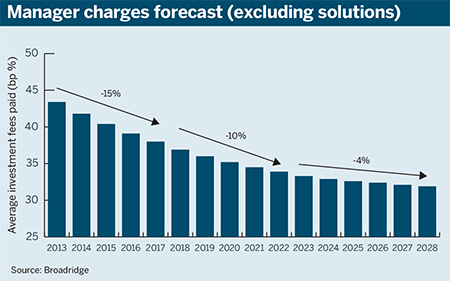Data Crunch: Broadridge's Johathan Libre takes a looks at the changes underway in the asset management fee environment
In the US, Fidelity recently launched the zero-fee share classes, while in Japan the Government Pension Investment Fund recently moved away from fixed-fee arrangements towards performance fees.
It may well be the case that we are entering a new fee paradigm that will fundamentally change the way institutional investors pay for investment services. We believe there are a number of factors forcing the industry to reconsider it approach to fees.
The push towards fee transparency will likely to lead to greater scrutiny on investment charges
One factor is consolidation. Larger institutions can negotiate lower fee levels. Schemes in the Local Government Pension Scheme have undergone investment pooling, with one of the stated objectives being to lower the investment costs paid.
We may see something similar within the corporate sector, given the introduction of pension ‘superfunds’, and master trusts have already established themselves as key players within the DC market.
The backlash against active
The relative performance track records of active versus passive over the past 10 years have resulted in a growing intolerance of active outcome uncertainty, and pockets of scepticism around the value that is added by active management.
There is also growing consensus that investment returns over the next 10 years will be much more muted, as the monetary environment hardens and quantitative easing programmes are unwound, and fees will therefore erode an increasingly large percentage of these lower gross returns.
The regulatory environment has also been influential. The imposition of the 75 basis point charge cap has certainly been effective in providing defined contribution members with low-cost investment strategies; the average member charge is now well below the cap. The push towards fee transparency will likely lead to greater scrutiny of investment charges.
Product innovation has also caused fee compression. Passive investing has allowed schemes to capture market beta, and factor investing now allows schemes to systematically capture some of the sources of alpha generated by active managers, and both of these types of approach can be accessed at a much lower cost than traditional active.
Note that lower fees from these product types allow for a greater proportion of a scheme’s fee budget to be spent on specialist high-alpha strategies (eg private equity).
A changing environment
While some asset managers may have aimed to protect the high fees they charge to existing clients, a greater number are now reconsidering this approach in order to more aggressively target new business.
Using data provided to us by asset managers on the fees they receive on individual mandates, and qualitative insights provided to us through interviews, we believe that downward fee pressure has driven the average bp paid by institutional investors globally to fall by approximately 15 per cent over the past 5 years.
We expect a further 10 per cent reduction in average fee levels over the next 5 years before the market stabilises.
For schemes that have not recently reviewed their investment portfolios, this new environment may present an opportunity to negotiate lower fee levels, or to explore using structures that may be better aligned to the desired outcomes.
These sentiments were echoed by a defined benefit trustee we recently interviewed: “Imagine if a big manager came out and said we recognise the world has changed.
As a result, we’ve looked at the way we are charging our clients, we’ve made improvements in pursuit of fairness and better outcomes, and we’ll offer this new idea to all existing and new clients”.
Jonathan Libre is principal in the EMEA insights team at Broadridge














